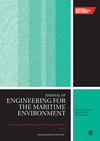d型肋粗糙度对波流复合流动侧壁边界层湍流结构的影响
IF 1.5
4区 工程技术
Q3 ENGINEERING, MARINE
Proceedings of the Institution of Mechanical Engineers, Part M: Journal of Engineering for the Maritime Environment
Pub Date : 2023-06-22
DOI:10.1177/14750902231181505
引用次数: 1
摘要
在实验室水槽中进行了湍流结构和湍流各向异性的实验研究,研究了单独流动和波流复合流动两种情况下光滑和粗糙侧壁面上边界层的湍流结构和湍流各向异性。水槽的粗糙侧壁包括一列圆形肋(直径,k)垂直连接,沿流向保持均匀间距p。在p/k = 2、3和4的条件下,对光滑表面和粗糙表面(肋)进行了实验,以重现d型肋粗糙度的不同情况。通过叠加两个不同频率的波,研究了波流相互作用的影响。利用声波多普勒测速仪获得了三种速度分量的时间序列数据。在近壁面区域,p/k值越高的粗糙度,湍流强度和雷诺应力水平显著提高。在侧壁面光滑的通道中,波流联合流动产生的湍流强度比壁面附近单独流动产生的湍流强度小。然而,对于肋壁情况,效果完全相反,即波流相互作用的流动比单独的参考电流产生更高的强度。肋壁面近壁区湍流长度尺度明显减小,表明粗糙度元素对湍流结构的影响较大。波的叠加使光滑壁和粗糙壁的长度尺度更小。随着肋间距(p/ k比)的增大,能量耗散率增大。各向异性不变图分析表明,肋壁附近的各向异性比光滑壁的各向异性减小。对于波流复合流动,雷诺数应力张量的各向异性不变数据在图边界内变化较大,反映了湍流状态的显著变化。本文章由计算机程序翻译,如有差异,请以英文原文为准。
Effect of d-type rib roughness on the turbulent structure of side wall boundary layer for wave-current combined flow
An experimental study has been carried out in a laboratory flume to characterize the turbulence structure and turbulence anisotropy in the boundary layer over smooth and rough side walls for both current alone and wave-current combined flow situations. The rough side wall of the flume comprises a train of circular ribs (diameter, k) attached vertically maintaining uniform spacing p along the streamwise direction. The experiments are performed for smooth surface and rough (ribbed) surfaces with p/k = 2, 3, and 4 to reproduce different cases of d-type rib roughness. The effect of wave-current interaction has been investigated by superposing waves of two different frequencies. Time series data of three velocity components are obtained using Acoustic Doppler Velocimeter. At the near wall region, roughness with higher p/k value enhances the level of turbulent intensity and Reynolds stress significantly. In a channel with smooth side wall, the wave-current combined flow produces lesser turbulence intensity than the current alone flow near the wall. However, for a ribbed wall case, the effect is completely opposite that is, wave-current interacting flow induces higher intensities compared to the reference current alone flow. Substantial decline in the turbulent length scales at the near wall region are observed for ribbed walls, which reveals the strong effect of roughness elements on the turbulent structure. Superposition of wave reduces the length scales even more for both smooth and rough wall cases. As the spacing between two ribs ( p/ k ratio) increases, the energy dissipation rate increases. The analysis of anisotropy invariant map demonstrates a reduction of anisotropy in the vicinity of ribbed wall compared to that for a smooth wall. For wave-current combined flow, the anisotropy invariant data of Reynolds stress tensor varies dramatically within the boundary of map, reflecting significant changes in the state of turbulence.
求助全文
通过发布文献求助,成功后即可免费获取论文全文。
去求助
来源期刊

CiteScore
3.90
自引率
11.10%
发文量
77
审稿时长
>12 weeks
期刊介绍:
The Journal of Engineering for the Maritime Environment is concerned with the design, production and operation of engineering artefacts for the maritime environment. The journal straddles the traditional boundaries of naval architecture, marine engineering, offshore/ocean engineering, coastal engineering and port engineering.
 求助内容:
求助内容: 应助结果提醒方式:
应助结果提醒方式:


